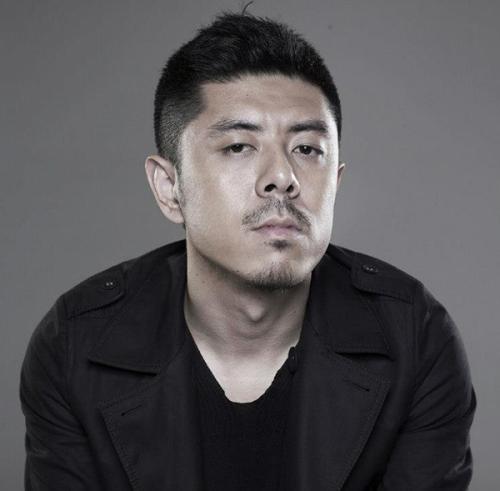We work for MAD 特别篇:MAD合伙人访谈之马岩松
1. 创立MAD至今,有哪些难忘的时刻?
最难忘的当然是创立MAD那一天了。 那是2004年的愚人节,我请了一堆朋友,结果自己却因为开车被追尾而迟到了(笑)。当时一大帮人挤在电梯厅,互不认识,工作室门也锁着,很尴尬,大家还以为是愚人节玩笑。
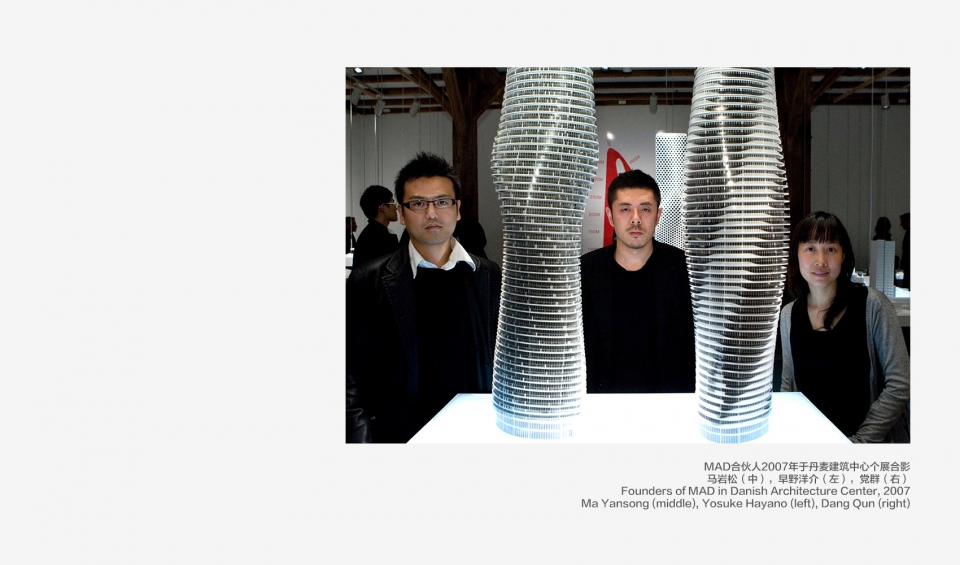
当初回国的初衷,觉得当时国内的城市有各种各样不同的问题,我希望回来,把工作建立在带有批判性的解决方案上。工作室的名字MAD,疯狂,其实也是一种态度,它好像不太关于建构,更关于破坏。工作室成立的日期也一直提醒我们身处在一个非常值得批判的文化环境里。我们既要认真,又不能太认真,不能把自己架到那种很传统专业的架势中。 十几年间作品无论大小,实现的那一天我的印象都很深刻。像梦露大厦,当时在中国建筑界属于超现实的事件,大楼建造花了几年时间,对我来说也就是一瞬间。卢卡斯博物馆也挺戏剧性的,跟那么多大师竞赛,做的时候完全没有包袱,也完全没想到会赢,只要把自己的态度表达出来就可以了。这些重要的时刻,好像早就在期待着,但又尽量不能太当回事。 ▼梦露大厦,MAD的第一个国际项目(点击这里查看更多)
Absolute Tower, the first international project of MAD (click HERE to view more) [url=]
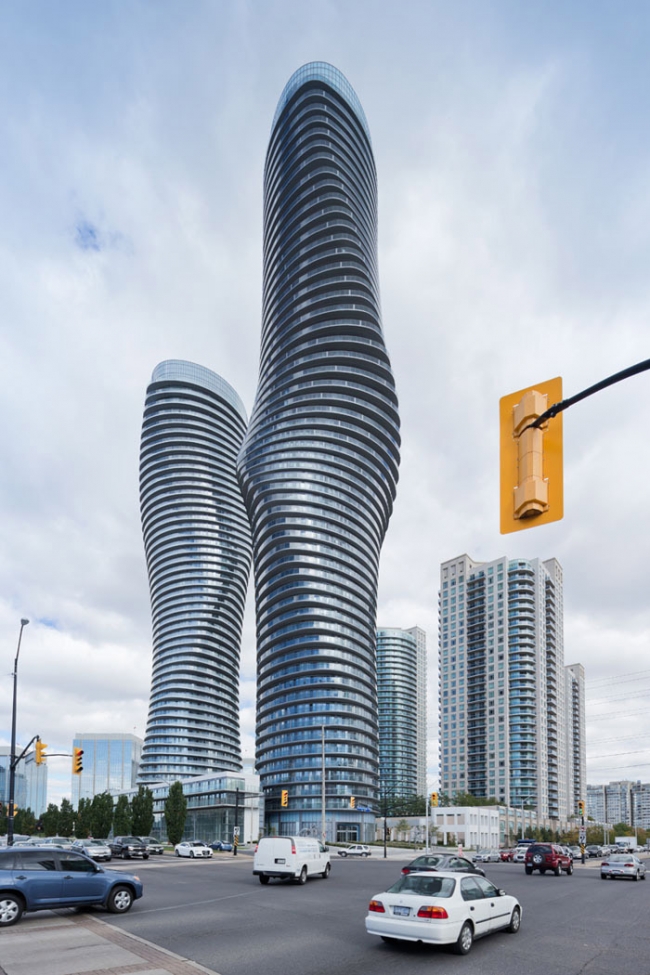 [/url]
[/url] Why I decided to go back to China was because back then I believed cities in China had various problems. I hoped my practices could possibly be critical solutions. The name of the studio, MAD, refers to madness, which can be also thought as attitude. It’s more about destruction, not that much about construction. The date that MAD was founded, also reminded me that we’re living in a cultural environment that needs criticism. We need to be serious, but not too serious, otherwise we might be stuck as those conventional and professional ones. Along the time, I was always impressed each time my project got completed, no matter what scale the project was. Like the Absolute Towers, it was sort of surreal back then in Chinese architecture industry. The few years the towers took to complete, was only a flash to me. Winning the Lucas Museum of Narrative Art was also dramatic to me. Even was competing with so many masters, I didn’t have any burdens when coming up with the design, and of course, didn’t think of winning at all. To show my attitude is all that matters. It seemed that I’d been expecting these moments for a long time, but I tried not to take it too seriously. ▼洛杉矶卢卡斯博物馆设计方案(点击这里查看更多)
Design proposal for Lucas Museum in Los Angeles (click HERE to view more)
[url=]
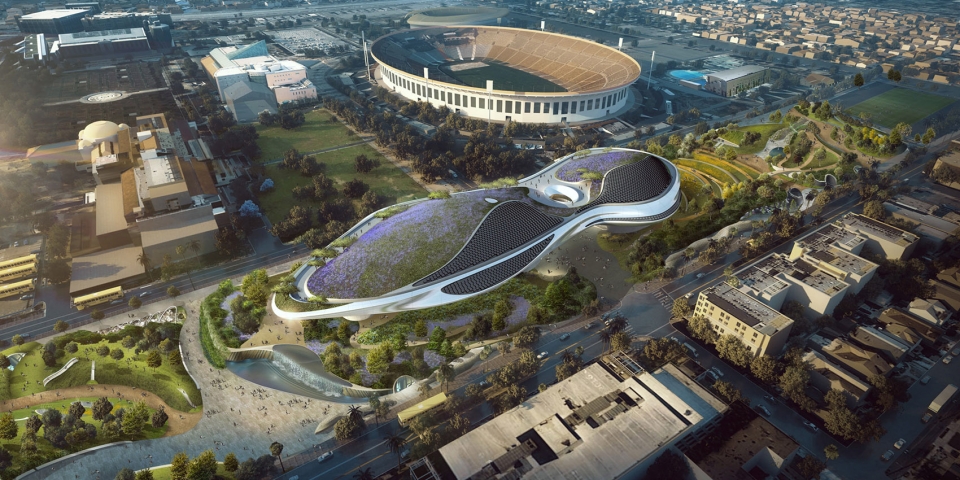 [/url]
[/url]
2. 你最大的收获是什么?
What is the biggest gain so far? 现在谈收获还早。很多建筑师钟情这个职业,大多是因为成就感:你可以实现你的作品,把貌似不可能的超现实的想法,变成影响周边人和文化环境的现实。从这个角度讲,每个项目的实现都是一个收获,它可以检验自己当时定义的乌托邦、当时的想象,变成现实后对未来的影响。 另一个收获是个人的思想变化。对于我来说,整个过程更多是思想的成长。那些不成熟的、甚至失败的作品,其实它们也为你铺垫了一条路,一条通往更成熟的自己的路,这对年轻人来说是必经的。对自己有质疑的时候,要坚信自己的初衷。 I think it’s still early to talk about gain. I guess why so many architects love their job is because you can have your works realized, and turn all those surreal ideas into reality that will influence surrounding people and cultural environment. In this way, all realized projects are gains. They can examine your then defined utopia and vision, and how they influence the future after being real. Other gain is my change in thinking. To me, the whole journey is more about the mental growth. Those immature, or even failed works, did actually paved a way for you, to become a more mature human being. This is inevitable to young people. You must stick to your original intention when you have doubts to yourself. ▼MAD部分作品一览,part of MAD’s projects
[url=]
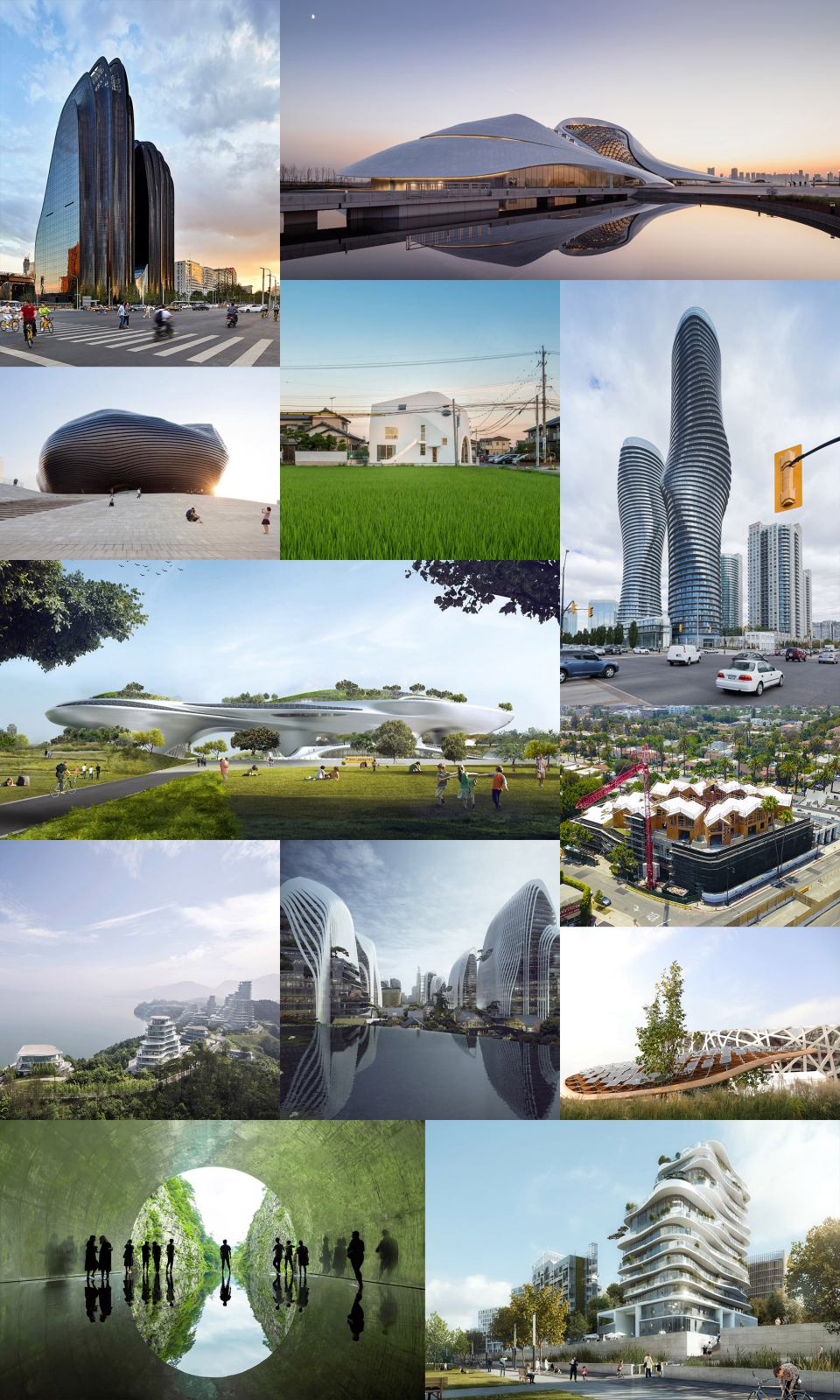 [/url]
[/url] 我一直觉得建筑也是一种文化,跟电影、音乐、艺术一样。它不该局限在讨论技术、材料的层面,而应该讨论更大的问题。建筑现在已经跟人的生活、文化、政治很好地连接了,连接的时候建筑就需要表现自己的独立性,不能从属于其他更强的领域,例如政治、资本。如果没有自己的话语,这个专业就不会被尊重,也更谈不上对时代产生影响了。 上一代建筑师,像日本的新陈代谢派,像欧洲的Archigram,包括后来在纽约MOMA的解构主义八人,他们的作品都很有实验性、理论性和批判性。政治正确的话题,他们不谈,而是描绘新世界。他们相对于当时其他形式的文化,一点儿都不输。这种热情在今天就非常缺乏,其实这预示着建筑专业的衰退。现在的建筑,谈绿色建筑,谈保护传统,谈公民建筑,谈这些会让建筑被优先认为是正确的话题。这样的讨论不能展现建筑真正核心的能量。我的长期目标,希望通过自己的一系列工作,把建筑足以改造文化和社会的魅力表现出来。 I believe that architecture is also a kind of culture, just like movie, music and art are. The discussion in architecture should not be limited to materials or technology only, but also some bigger issues.Architecture is already tightly connected with people’s life, as well as culture and politics. Thus, it must keep its independence to avoid from being subordinated to more powerful domains, such as politics or capital. Architecture must speak for itself, or it will never be truly respected, let alone having an effect to the period we’re living in. The works of last generation of architects, such as the Metabolism in Japan, the Archigram in Europe, and the later 8 architects of deconstructivism from New York MOMA, are all experimental, theoretical and meanwhile very critical. They rarely talked about topics that are politically right; instead they dedicated to blueprint a new world. The culture they represented back then didn’t lose to any other format of culture. This kind of passion is exactly what we are lack of today, which in some way indicates a setback in architecture. People nowadays talk too much about green architecture, protecting the traditions, and civic architecture, these kinds of politically right topics. However, such discussions could not reveal the true power of architecture. My long-term goal is to show the charm of architecture, which can transform culture and society.
3. 我觉得您像一位斗士。
I feel like you are a fighter. 中国正处于一个实用主义的时代,这跟近现代中国以经济发展为核心有关。文化是需要积累的,而且没有绝对的对错,所以对建筑的判断不会像理工科那样有明确答案。中国建筑行业受西方现代主义影响非常大,上一代受西方现代主义影响的人回国,参与教育建设,基本上都不是在建立自己的思想体系,而是在想怎么做西方的“好学生”。但问题是,所有的好学生是一样的,他不认为建立自己的话语,或者有不一样的价值是最重要的。在这里,你不能承受作为一个不一样的人,或者作出不一样的建筑,产生不一样的思想,这些会引致大家所惧怕的争议、批评。 现代主义从西方发源,第一代大师对这段历史的世界性文化影响已经盖棺定论。它在其他地方的落地性怎样,现代主义作为思想在世界上的生命力如何,对西方来说是一个意义重大的话题。而作为和西方有着不同文化背景的地区,像日本,对这种情况就产生了危机感,很坚定地要做日本当代建筑,建立起自己的文化来反哺西方。中国在这方面还非常缺乏。中国建筑师的个体很难脱离中国建筑师团体,作品很难脱离于主流西方建筑界。他们更倾向于被认同,而不是去挑战。中国未来非常需要年轻一代的建筑师建立自己的价值,被更大的文化体去关注、去尊重。 China is in an era of pragmatism, which is influenced by the pattern of development that economy is on top priority. However, culture needs to be accumulated. There is no absolute standards to evaluate culture, and thus it is different to evaluate architecture from how we evaluate science and technology. The architecture industry in China is greatly influenced by the western modernism. In fact, the previous generation who received education overseas barely built our own ideology, instead, they thought too much on how to be a “good student” of the West. That is the problem. Good students are all the same. They don’t think it’s the upmost important to have one’s own voice or different value.In here, one can hardly bear to be a different individual, having a different kind of design, or having different kinds of ideologies. All these will lead to controversy and criticism that people are afraid of. Modernism was originated from the West, and its influence to the global culture from the first generation of modernism masters has already been conclusive. However, it is still a significant topic to investigate both the localization of those Modernism projects in other parts of the world and the status of the development of Modernism as a theory that has been globally applied. On the other hand, as a country who has a totally different cultural background from the West, Japan was firmly determined to create their own specific contemporary Japanese architecture and to build its own cultural system to feed the west. China is still immature in this regard. It is quite difficult for Chinese architects to break away from their community, and their practice is hard to break away from the mainstream of western architecture. They are more inclined to be approved than to challenge. China is now in an urgent need of a new generation of architects to build their own values to be respected by a larger group of culture.
4. 最初和其他两位合伙人是怎样相遇并决定一起开创事业?经过多年发展,三位合伙人的合作方式有哪些变化?
How did you meet the other two partners and decided to work together? How has your collaboration with them been changed after years of practice? 我的朋友不多,所以我觉得能跟我成为朋友的,肯定是能合伙的。当年我跟Yosuke一起工作,一起半夜下班,一起吃饭然后各回各家。有时候我想做竞赛就叫上他,做到早晨再一起去上班。有一天我和他说:我觉得中国问题很多,想自己做工作室,用自己的方法去给这个情况打一针,你要不要一起?”从文化上来说,当时整个亚洲建筑师面对的情况差不多。当时日本建筑没有这么牛,也有很多问题,当时走的路跟中国现在走的路很像。我跟党群当时是通过网上的在美中国建筑师群体认识的,当时她说中国有很多机会,也有很多问题,我们(在美的中国建筑师)可以做些什么。就这样她就遭到了一帮美国留学生和建筑师的“攻击”。他们以人在美国为荣,就像今天中国的知识分子要远离现实一样,怕接近中国染上更多问题。这不是很可笑吗?建筑师本身就是解决问题的人,哪有问题就应该去哪,要非常入世地去把理想实现。后来那些“攻击”她的人很多也回国了(笑)。 我们三个初衷挺相似:年轻时在国外受教育,但是又不甘于受到的教育与现实问题脱节,想投身进来干一番。我们三个人没有谈过明确的分工,每个人长短处是什么,分工很自然就形成,谁更擅长什么就管什么。 I don’t have many friends, so whoever can be my friend should be able to be my partner. Back then Yosuke and I often worked late together, had late night dinner and went home after. Sometimes if I did competitions, I’d worked with him after office hour, all the way overnight and came back to work in the morning. One day, I said to him, “ I think there are many problems to deal with in China, and I want to do practice in my own way, to see if can solve any problems. Would you like to join?” At that time, from a cultural perspective, most of the Asian architects were facing a similar circumstance, including those who were from Japan. Dang Qun and I knew each other in an online group of Chinese architects who practiced in America. She once said that China was full of opportunities, while also had a mass of problems, and she wanted to do something. Such a speech was immediately “attacked” by many architects and students of that group. Those people were proud of being in America, just like many intellectuals in China nowadays, wanted to be away form the reality, fearing of the unpredictable problems that they might encounter in China. Wasn’t it ridiculous? Architects are the ones to solve problems and take the initiative to achieve the ideal plan.Soon afterward, many of those who had “laughed at” her went back to China (laughs). The three of us have a similar vision: we received professional education overseas, but unwilling to accept the fact that the education we received split with the reality. We intended to devote ourselves to architecture.We had never talked about the division of work. It’s quite natural and easy for us to divide. Everyone is the manager of what he or she is good at. ▼MAD三位合伙人和公司员工于新办公室楼顶合影
Froup photo of MAD on the roof of the new office [url=]
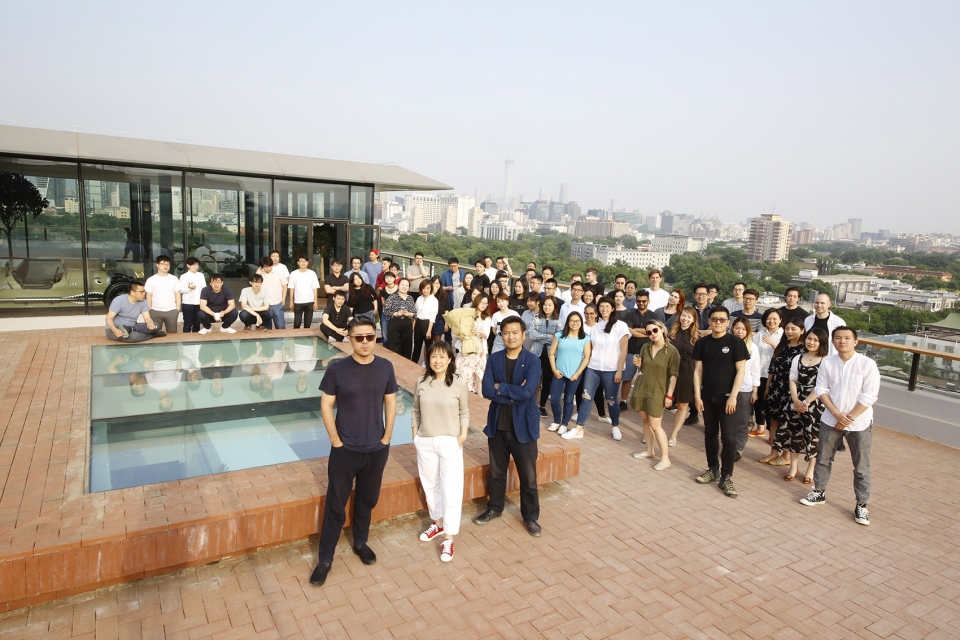 [/url]
[/url]
5. MAD已经超过100人,现在公司的构架是怎么样的?未来还会继续扩大吗?你希望MAD成长为一个什么样的公司?
MAD now has a team of 100 people. What is the current structure of the company?Will it continue expanding in the future? What is your plan and vision for the future of MAD? MAD更像一个研究文化的机构,我们有很多年轻人,很多讨论。我们会举办很多课程,谈艺术、谈文化,古典的、现代的。我特别反感那些“好学生”,或者那些一成不变的、可以依靠经验轻松驾驭完成工作的。我要求每个员工都要思考,保持批判性,不只是对工作的环境和内容保持思考,也要对自己本身保持思考。无论是20人,还是50人、100人,我从来没有想过要因为人数去把公司流程化、模式化、品牌化。我想保持这种自我思辨的环境,对每个作品都进行自我质疑,而不是靠管理制度、因为某种惯性去做决定。我还是更希望把自己内心对这项工作的感受、情感放在第一位。 MAD is more like an institute dedicating to culture research. Our staff is interested in many kinds of discussions. We frequently hold courses on arts and culture, whether it’s modern or classical. I don’t like those “good students,” or those who can’t jump out of their comfort zone but just finish their work simply by experience. I ask each of my staff to keep critical thinking, not only about work, but also on themselves. I never thought about operating my company in a processed, patterned and branded way, no matter it has 20 or 50 or 100 employees. I would like to maintain the environment where everyone is able to think and question on each piece of work, instead of relying on any regulations or “inertia”. I’m more inclined to put my real feelings and emotions of the work in the first place. ▼MAD新办公室,MAD new office [url=]
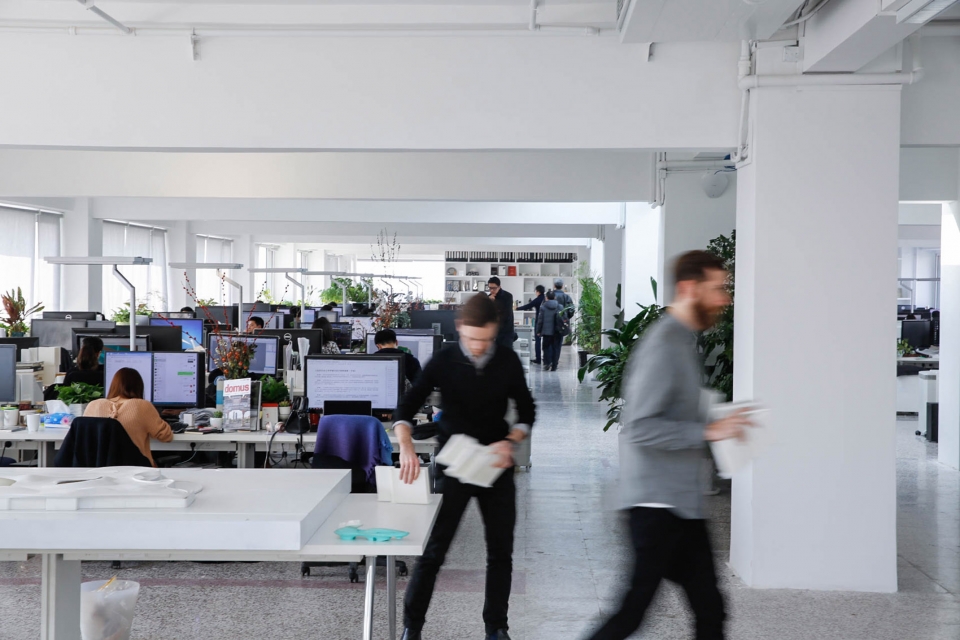 [/url]
[/url] 我觉得建筑师分两种,一种非常自我,像高迪,像弗兰克·盖里,像扎哈。我特别欣赏这种建筑师,他们的存在本身就是建筑的历史。我跟弗兰克·盖里聊天,他说自己出道比较晚,早期做的都是传统加州风格的作品,后来改造自家的厨房,被后人称为是解构主义代表作。他的朋友说:你对自己家的改造和平时工作做的项目完全不同,如果你自己不愿意,为什么工作要那么做?于是第二天他就停下了所有工作,决定忠于自己的内心。他形容这个感觉就像是从悬崖上跳下去,特爽。我觉得就是这样:你只能做自己,如果你对事情的理解能在自己的作品里有一个发展,那就是你想做的;如果你的思想死了、或者停了,那就是结束的时候。另一种建筑师会发现一种可以被复制、被其他人学习利用的方法,这个社会也需要这样的建筑师。这两种建筑师不一样,我是更关心自己感受的那种。 I think there are two types of architects. The first kind is people very self conscious about themselves, like Antony Gaudy, Frank Gehry and Zaha Hadid. I particularly appreciate this type of architects, whose existence itself is already the history of architecture. Frank Gehry once told me that in the early years, he was engaged with cases in a strong traditional California style. However, he was later considered as a master of deconstruction due to his renovation work on his own kitchen. One of his friends said to him: “What you have done to your home is totally different from what you do in your daily work. If you have to work against your will, is it still necessary to do that? ” So the next day he stopped all the work and decided to be true to his own feelings. He said it felt desperately good, like jumping off from a cliff. I think that’s the way it is. You can only be yourself. If your understanding towards something can have a further development through your own works, then that should be something you should stick to. If your thinking is dead, or stops, that’s when everything should end. The other kind of architects knows the way that can be copy-pasted and learned by others. We also need this kind of architects. These two kinds are totally different. But to me, I prefer the one who pays attention to his/her own feelings.
6. MAD的项目分布在世界上多个国家。在面对国外业主与环境和国内业主与环境时,工作方式最大的不同是?
MAD has projects all over the world. What is the difference in your work style when you are working with foreign clients in different countries? 建筑对人和文化的影响,人和文化对建筑的反应,以及他们之间所产生的对话,是我最关心的。 无论在国外工作和在中国工作,面临的问题都不一样。业主什么样的都有,有的非常信任你尊重你,有的则有他自己的方法,这对我来说都不重要。我一直关注的,是做这个工作的目标是什么?能不能实现这个目标?我之所以要去欧洲、去日本、去美国做建筑,是因为对不同的文化环境的好奇。这种碰撞是我感兴趣的。我去巴黎做项目的时候,会想巴黎美术对中国的影响那么大,我一个年轻的中国人跑来能干什么?我做的东西能证明什么?又能带来什么?我去美国的时候,面对的是星球大战的导演,是美国的主流文化,我很好奇他对我这样一个年轻的亚洲人设计的东西是什么看法。我喜欢这种文化上的对话,而这种对话也会反过来影响我。日本四叶草之家,项目非常小,但业主觉得我在中国是一个厉害的建筑师,所以他不会给我提任何要求,怕我不好好帮他设计。但恰恰因为这样,我对他们家庭,对这样的一个小项目反而战战兢兢、小心翼翼,变得比他们更敏感、谦虚。 ▼与不同文化对话 – 巴黎蒙帕纳斯大厦改造方案(点击这里查看更多)
Dialogue with different cultures – design proposal for the Renovation of Paris’ Montparnasse Tower (click HERE to view more)
[url=]
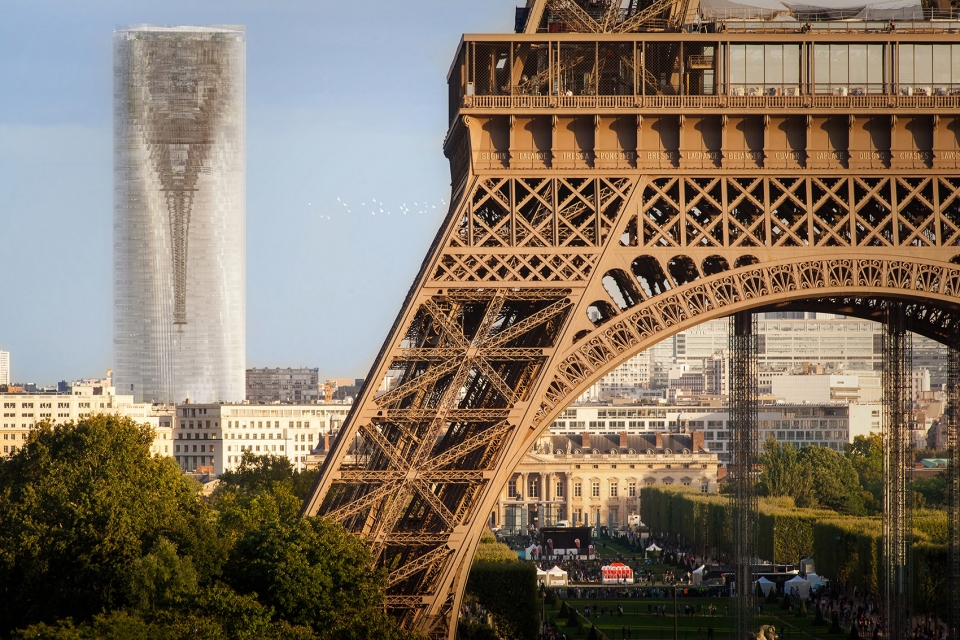 [/url]
[/url] ▼与不同文化对话 – 洛杉矶“花院”(点击这里查看更多)
Dialogue with different cultures – Garden House in Los Angeles (click HERE to view more)
[url=]
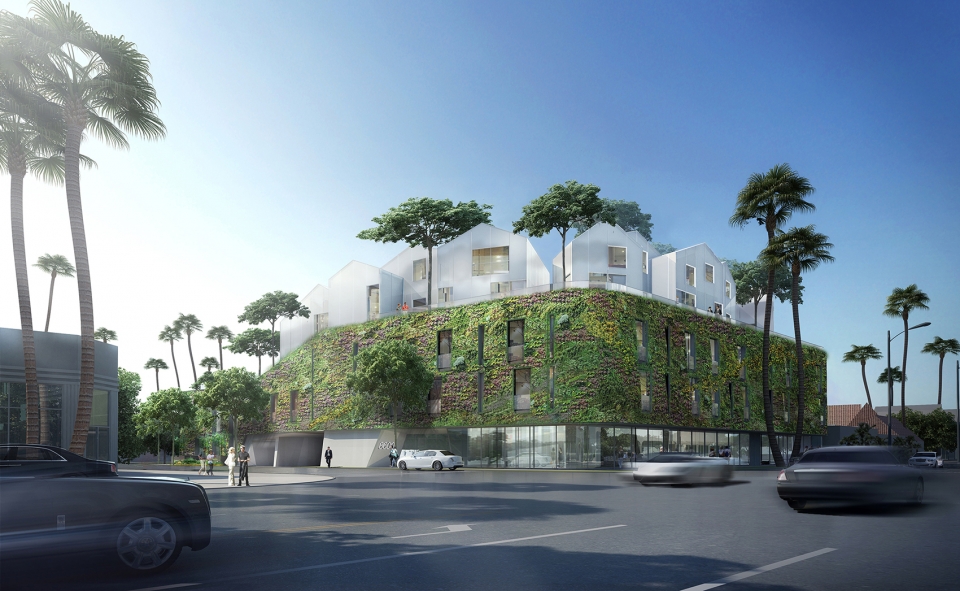 [/url]
[/url] The influence from architecture to people and culture, and the response from people and culture towards architecture, a well as the conversation between them, is what I care about the most. We have to face different problems no matter working on projects in China or abroad. There are various types of clients. It is not important to me whether the client respects me or prefers to stick to his own way. What I care about is what I could achieve through the project and how to achieve it. That is why I do projects in Europe, in Japan, in the US. It’s because I am curious in different cultures. I find this kind of cultural collision very interesting.When I do the Paris project, I could not help thinking what I could do as a young Chinese architect in this art city, which has influenced China a lot. What can I prove and what can I bring to this city? My client in the US is the creator of the “star war” series, and he represents American mainstream culture. I am curious to know what he thinks of the design by me, a young Asian designer. I am fascinated by this kind of “conversation” between different culture and it could affect me in turn. The Clover House in Japan, it’s a quite small project. The client didn’t raise any requirements, just because he thought I am a famous architect in China and he worried that I wouldn’t take his small-scale project seriously. Exactly that, I was moved and more careful on the project, more sensitive and humble than the client is. ▼与不同文化对话 – 日本四叶草之家,保留原有屋架(点击这里查看更多)
Dialogue with different cultures – Clover House in Japan, remaining the original wooden structure (click HERE to view more)
[url=]
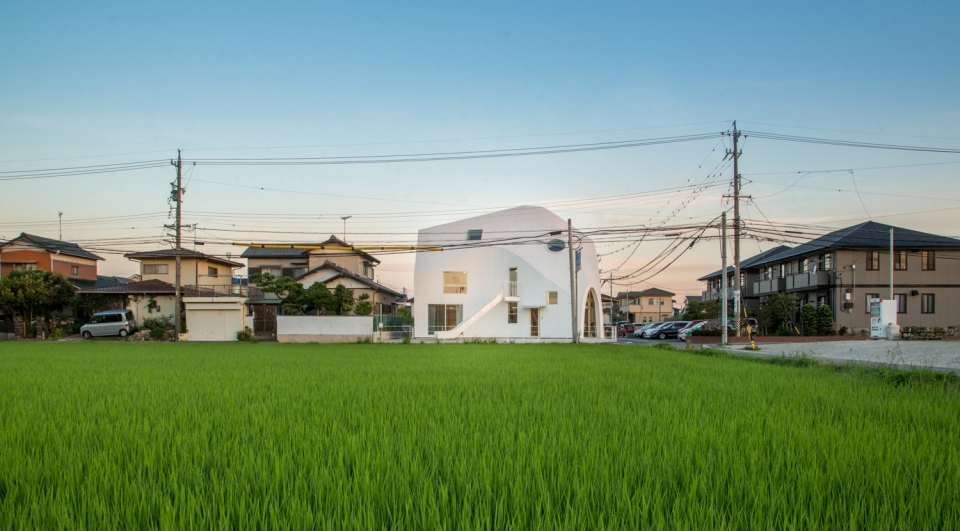 [/url]
[/url] [url=]
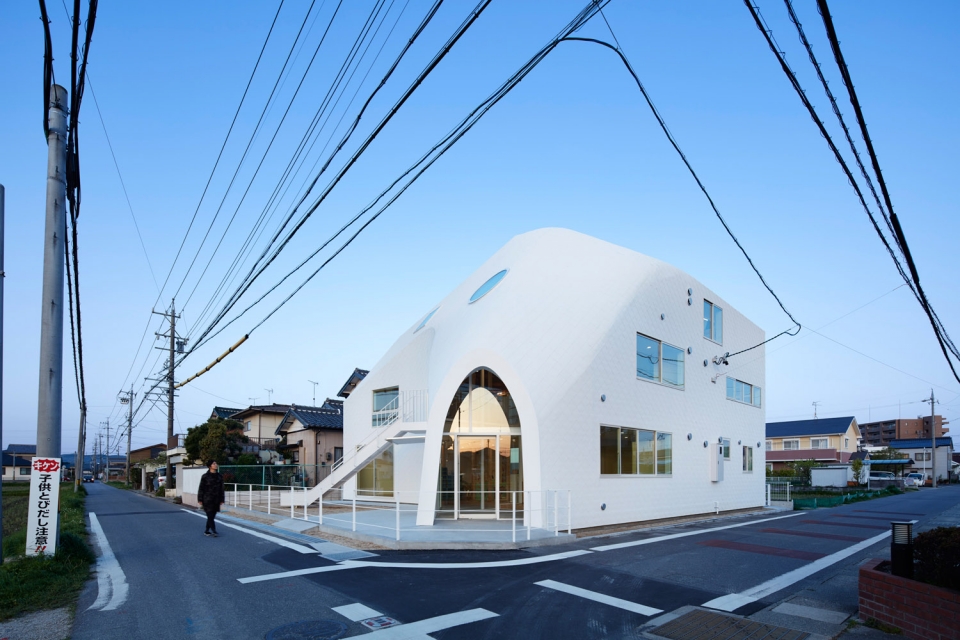 [/url]
[/url] [url=]
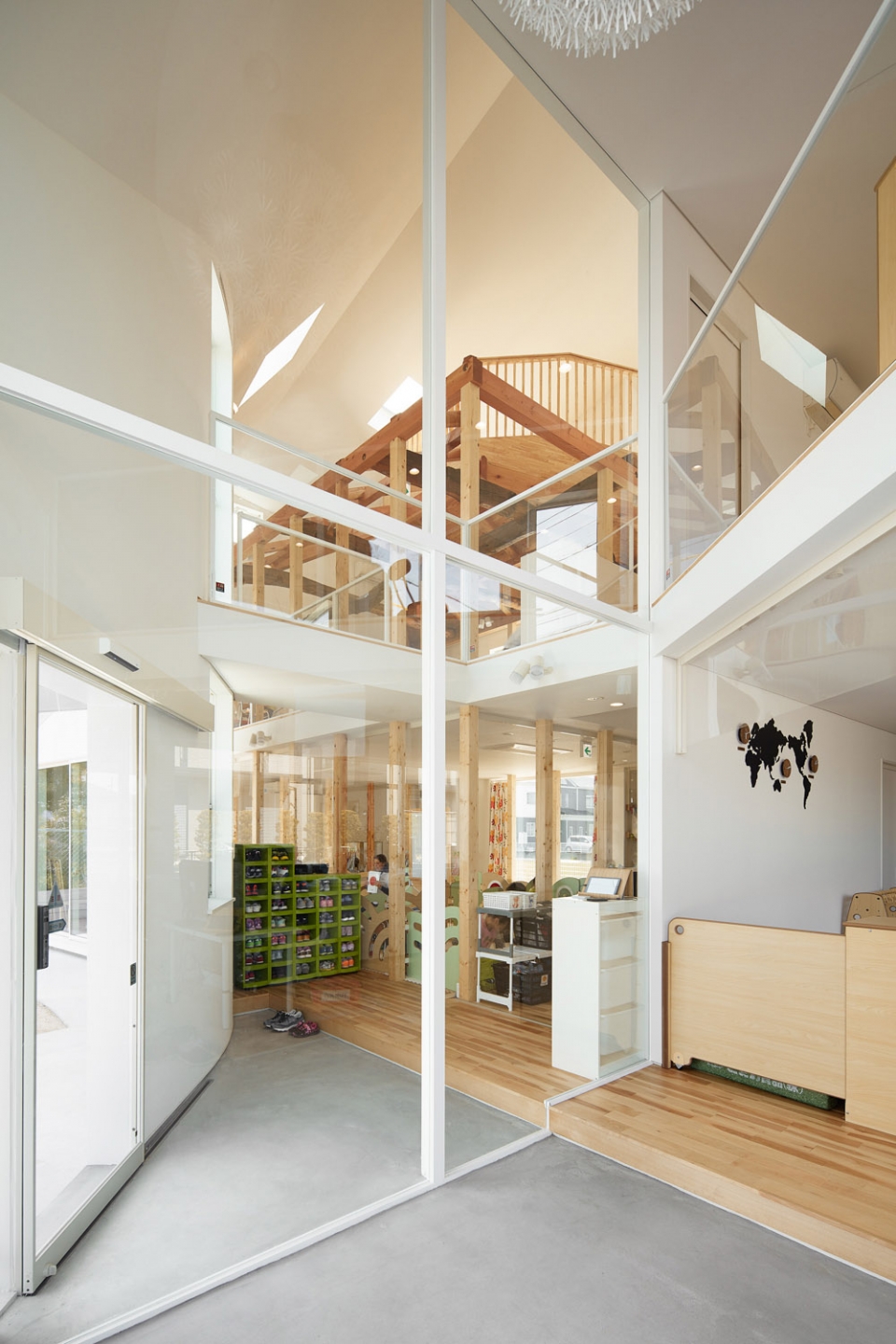 [/url]
[/url]
[url=]
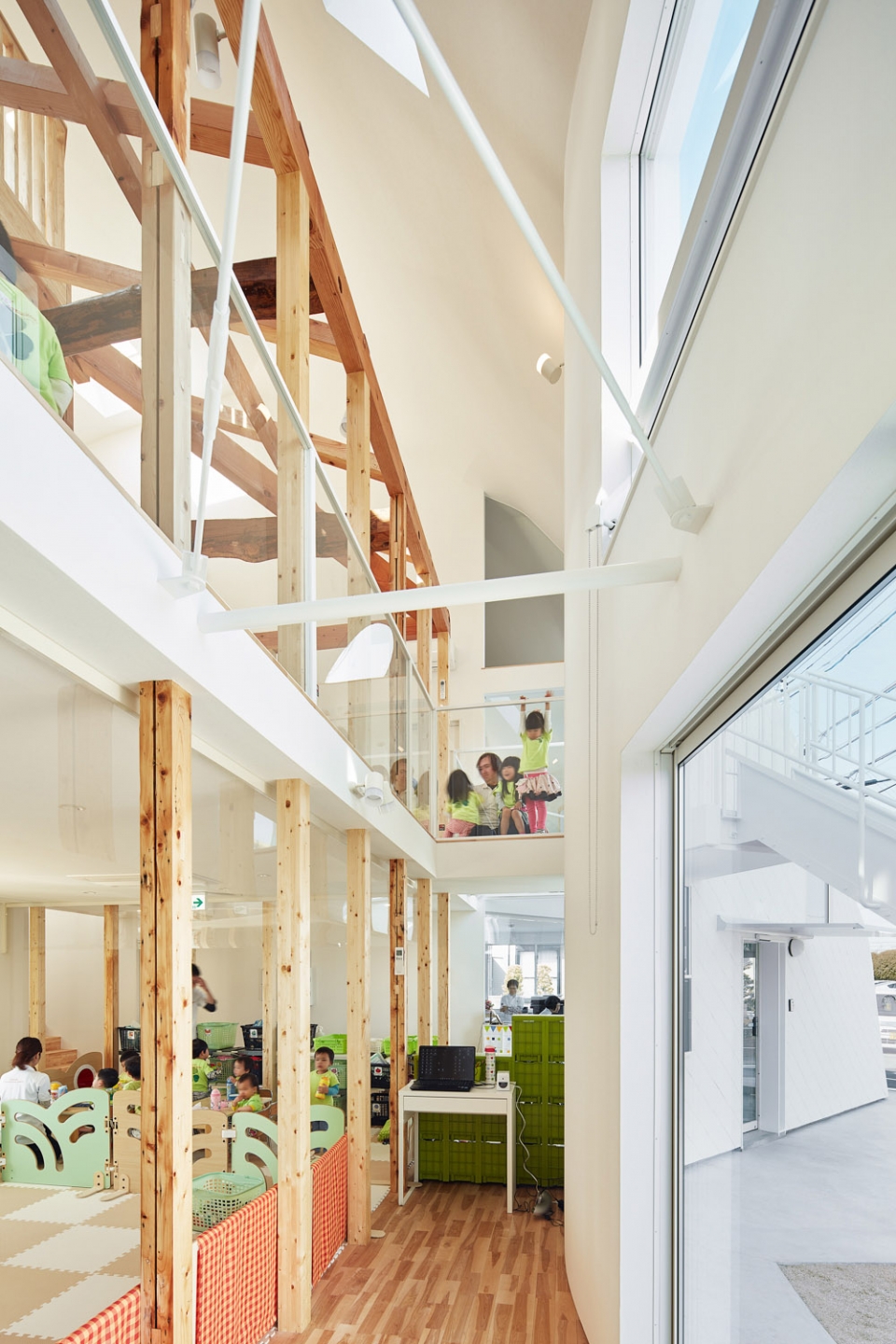 [/url]
[/url]
7. 您认为“山水城市”这个理想在当前中国发展遇到的最大困难或挑战是什么?目前行业能做的有哪些?
What is the biggest challenge to explore your idea of Shanshui City in China and what could you do to achieve this idea in current situation? 首先我再介绍一下“山水城市”。 中国现在的城市基本上是按照西方现代城市的思路发展,这种模式让中国城市背离了传统城市文化中所赞美的那些质量。这些质量是关于自然,关于情感,关于人深层的文化信仰,在现代城市中是缺失的。但同时我们又不可能回到以前的那些传统城市,因为现在无可避免需要高密度的现代城市,这个问题怎么解决?当年钱学森说希望建一个城市,有现代功能的同时又有诗情画意,以重建人和自然的情感联系为目标,而不是物质、资本或权力。这也是我的基本想法。但我的建筑实践往往会被误认为是解读“山水城市”的唯一方法,这是挺大的困境。我的实践带有个人色彩,可能会影响到一些人,甚至让一些人对“山水城市”产生质疑,但不复制千篇一律的西方城市这个观点是没有人反对的。 I would like to reintroduce Shanshui City first. Basically most city development China is based on the modernism from the West, which will make Chinese cities no longer lay emphasis on the good qualities from the traditional urban culture. These good qualities are about nature, emotions, and the people’s deep faith in culture. These are exactly what modern cities nowadays are lack of. However, it is impossible to restore the traditional cities as high density is inevitable in modern city. Then what can we do? The scientist Qian Xuesen once mentioned that he looked forward to seeing a kind of new city, that is on one hand modern, fulfilling all the functional needs, and on the other hand also idyllic. Its focus is more about rebuilding the emotional connection between human and the nature, instead of serving the capital or power. This is also what I believe in. However, many misunderstand that my practice is the only way to reinterpret “Shanshui City”. My practices are quite personal that might influence some people, or even make them have doubts on “Shanshui City.” But I guess nobody will be against the idea that we should not just copy the West. ▼《山水城市》出版物,book of Shanshui City [url=]
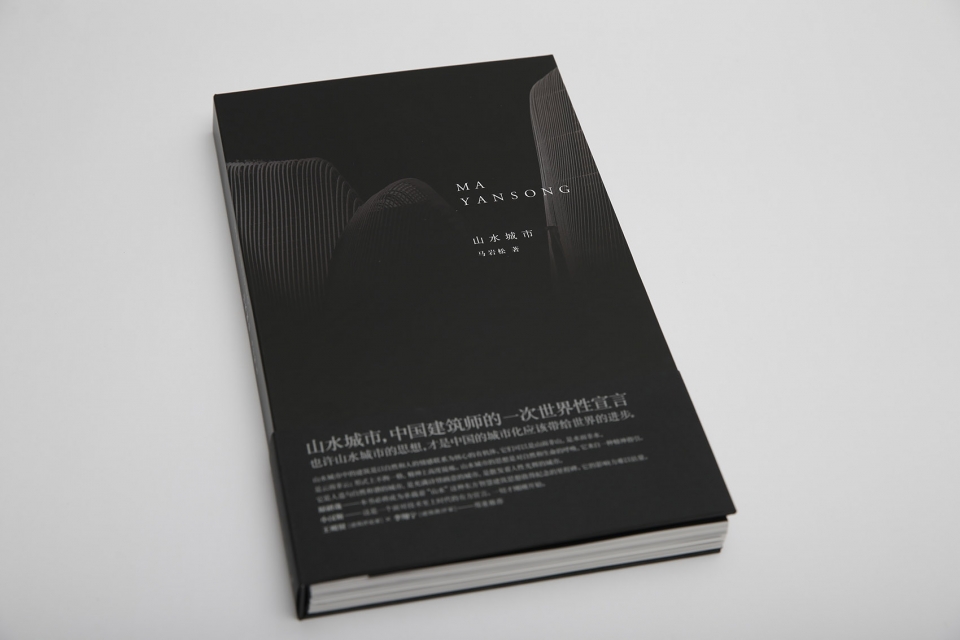 [/url]
[/url] 那我们该怎么做?这应该是中国的知识分子、建筑师、规划者思考的问题。我们应该在传统城市中找到一种基因,它在文化上和情感上跟自然有关。中西方对自然的看法非常不一样。西方城市谈绿色建筑和可持续发展,是从物理技术层面而不是情感层面谈的,不认为人是自然的一部分,或自然为人的精神拓展。从这个角度讲,我受传统文化的价值影响非常大,特别看重对传统的解读。我希望我的作品不是在视觉上跟传统建筑产生必然联系,而是表达出在对未来的,想象力的,更深的层次上对传统文化的理解。 Then what should we do? This should be something Chinese intellectuals, architects and urban planners to think about. We should decode the gene of traditional Chinese city that is related to the nature both in culture and emotion. It’s quite different how the East and the West treat nature. The West talks about green buildings and sustainability, from the physical level instead of emotional level. They don’t think that human is part of the nature, or the nature is the spiritual extension of human. In this way, I am strongly influenced by the eastern traditional cultural value, which pays much attention to the interpretation of the traditions. I hope my works are not simply connected to the traditional value in visual, but they can somehow show how I understand the traditional value, and put them with imagination for the future. ▼山水城市实践 – 北京朝阳公园广场(点击这里查看更多)
Practice of Shanshui City – Chaoyang Park Plaza (click HERE to view more) [url=]
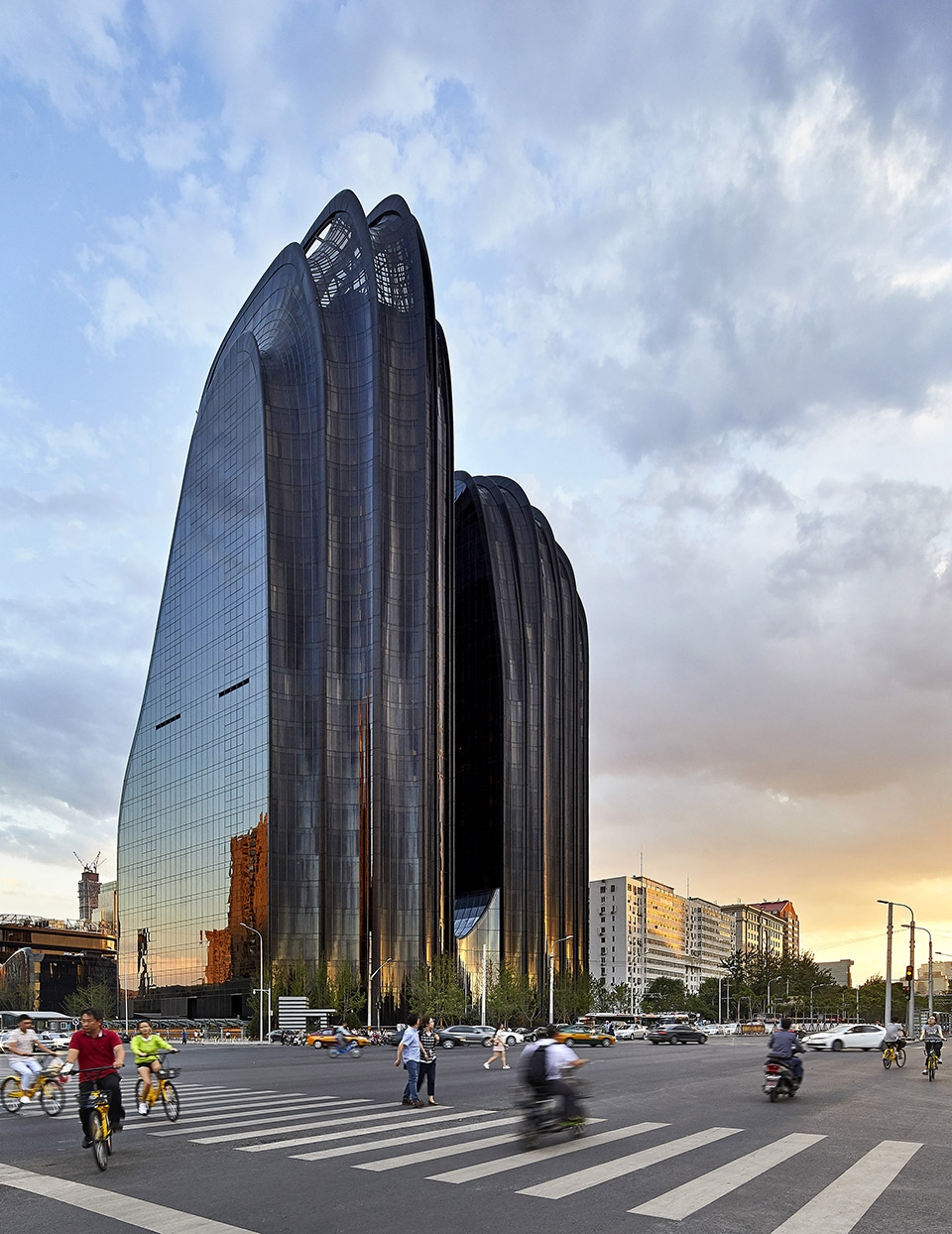 [/url]
[/url] ▼山水城市实践 – 南京证大喜玛拉雅中心(点击这里查看更多)
Practice of Shanshui City – Nanjing Zendai Himalayas Center (click HERE to view more) [url=]
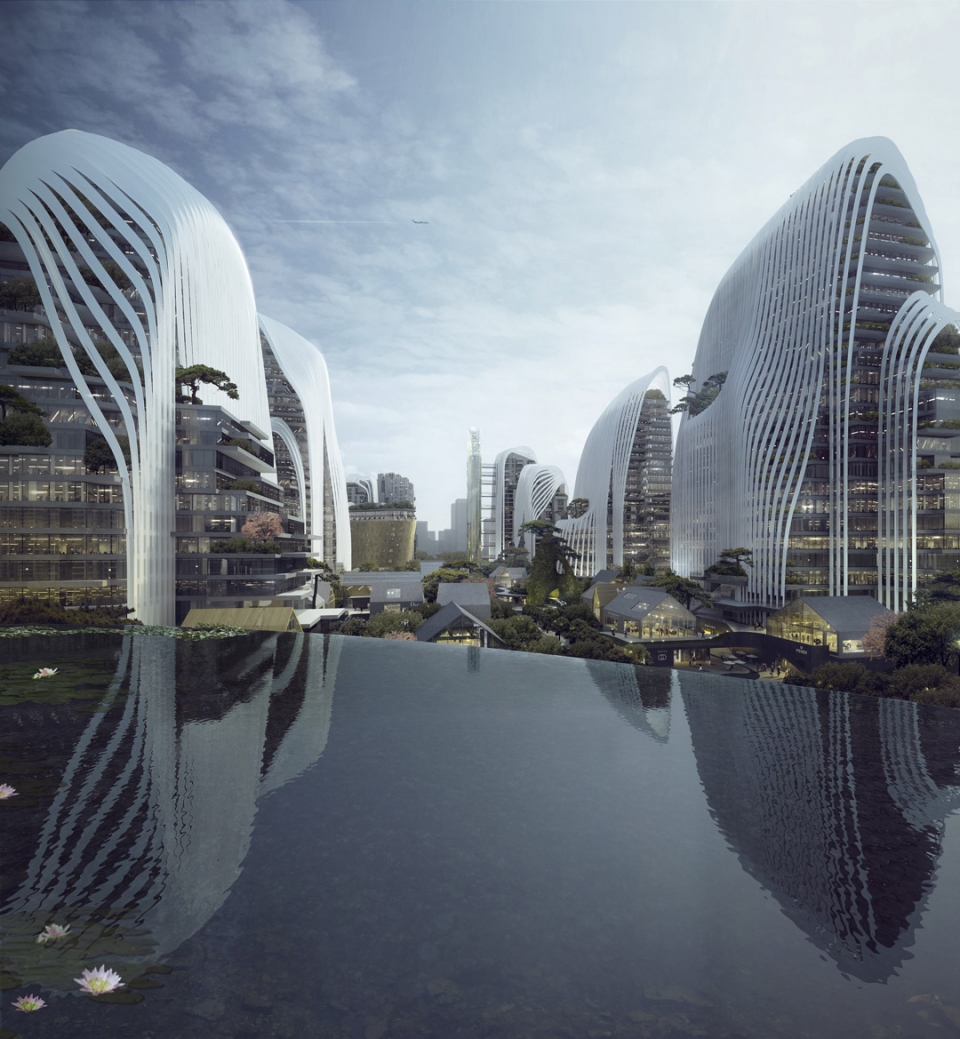 [/url]
[/url] ▼山水城市实践 – 黄山太平湖公寓(点击这里查看更多)
Practice of Shanshui City – Huangshan Taiping Lake Apartment (cllick HERE to view more)
[url=]
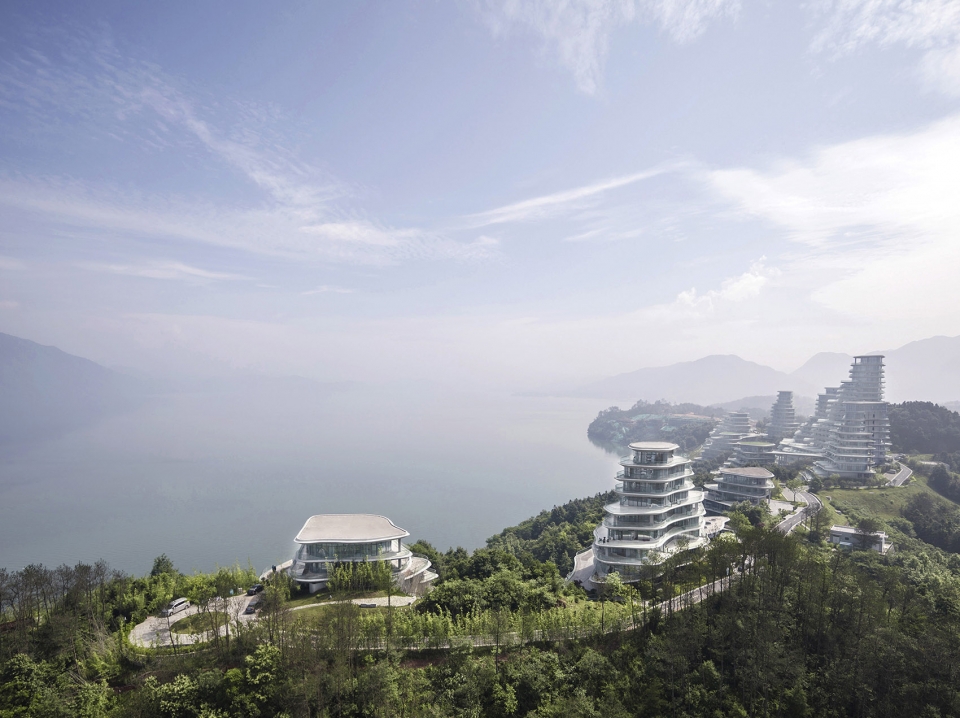 [/url]
[/url] 我不把自己的实践当成对“山水城市”一种正确解释,更把它当成实验。过去几十年的城市化过程中,建筑师对于中国犯下的错误是有共识的。再过几十年,中国的新城市文明对世界的贡献是什么?这是大家的问题。从这方面讲,我不认为我的理念在实践和接受度上有什么大问题。主要的困境还是来自于自己:实验能走多远,对自己的实验有没有信心,等等。 I prefer to take my practice in Shanshui City as experiment rather than a correct answer. The past decades, China was experiencing rapid urbanization and has made many mistakes. We have to think about what Chinese city could contribute to the world in the future. This is a question to be answered by all of us. In this way, I don’t think it’s a big problem how others take and accept my philosophy and practices. The major difficulty comes from myself: how far the experiment can go, if I am confident in my experiments, etc. ▼马岩松2013年于北京吾号个展“山水城市”(点击这里查看更多)
Shanshui City Exhibition in Beijing WUHAO, 2013 (click HERE to view more)
[url=]
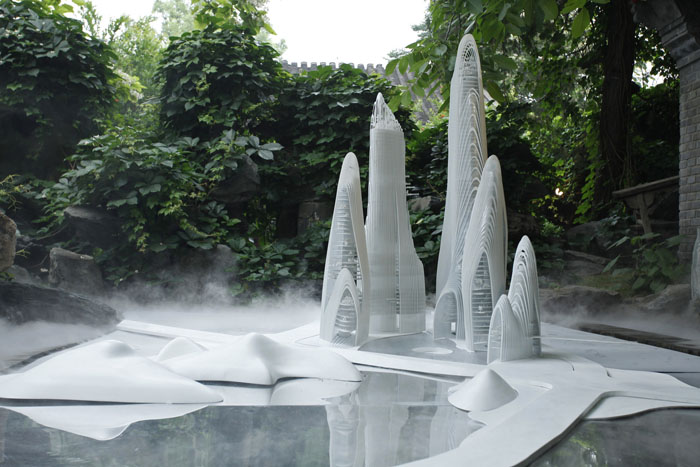 [/url]
[/url]
[url=]
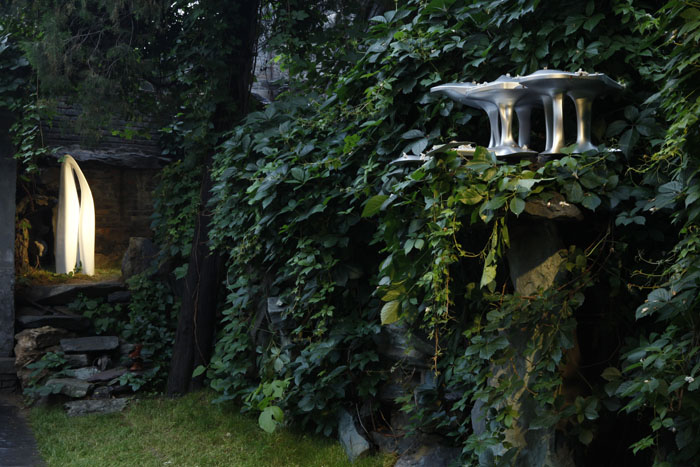 [/url]
[/url]
[url=]
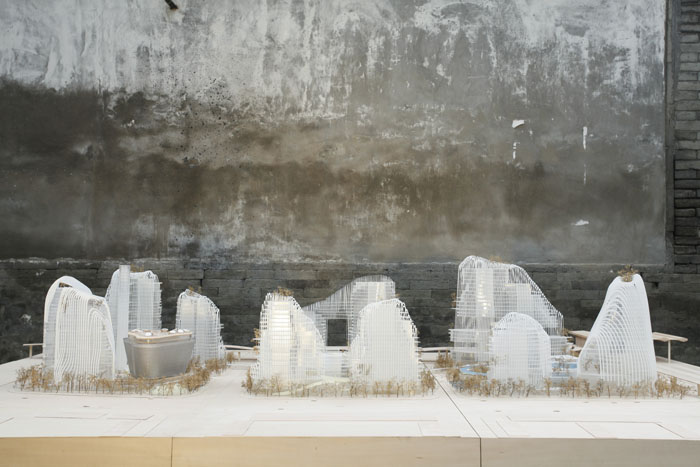 [/url]
[/url]
[url=]
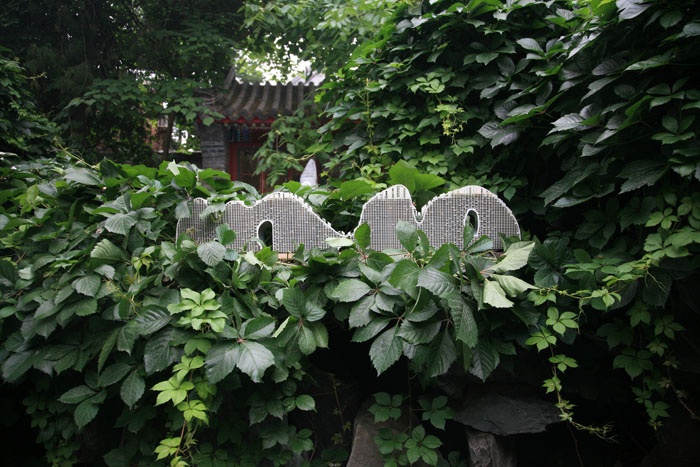 [/url]
[/url]
8. 朝阳公园项目建成后受到巨大的关注和争议,你怎样看待这些争议?可以告诉我们多一点这个项目背后的故事吗?
The Chaoyang Park Plaza raised heated discussions and controversy after it’s completed. What do you think of the discussion? Could you tell us something behind the project? 大家去质疑城市里那些特别的东西的时候,可以想象如果没有它们,你会怎么评论这个城市。这个项目跟周边城市环境的反差对我来说很重要,因为我不想建一个像CBD那样的建筑群。央视建造的时候,库哈斯说未来中国的CBD肯定和西方差不多,高楼林立,高层是各种银色的绿色的蓝色的玻璃幕墙,这样的城市是“高楼扶摇直上,想象力轰然倒塌”。正因为他点中了这个死穴,央视才决定要做不一样的东西。人们对他的作品也有不同看法,但是他质疑和预言的确实发生了。 When people are questioning those special things in the city, you should imagine what the city would look like without them. I did not want to build something look like the CBD. To create the contrast between this project and its surrounding urban environment is the most important to me. When Rem Koolhaas designed the CCTV towers, he said the future CBD in China would look similar to the West. All kinds of skyscrapers, glass curtains of all sorts of colors, silver, green, blue… The competing skyscrapers imply the collapse of imagination. Just because he pointed out the key point that the CCTV decided to do something different. People might have different opinions about his works, but what he questioned and foresaw did happen. ▼朝阳公园广场位于朝阳公园旁,在北京城市中显得别具一格(点击这里查看更多)
Chaoyang Park Plaza is close to Chaoyang Park, standing out from the surroundings (click HERE to view more)
[url=]
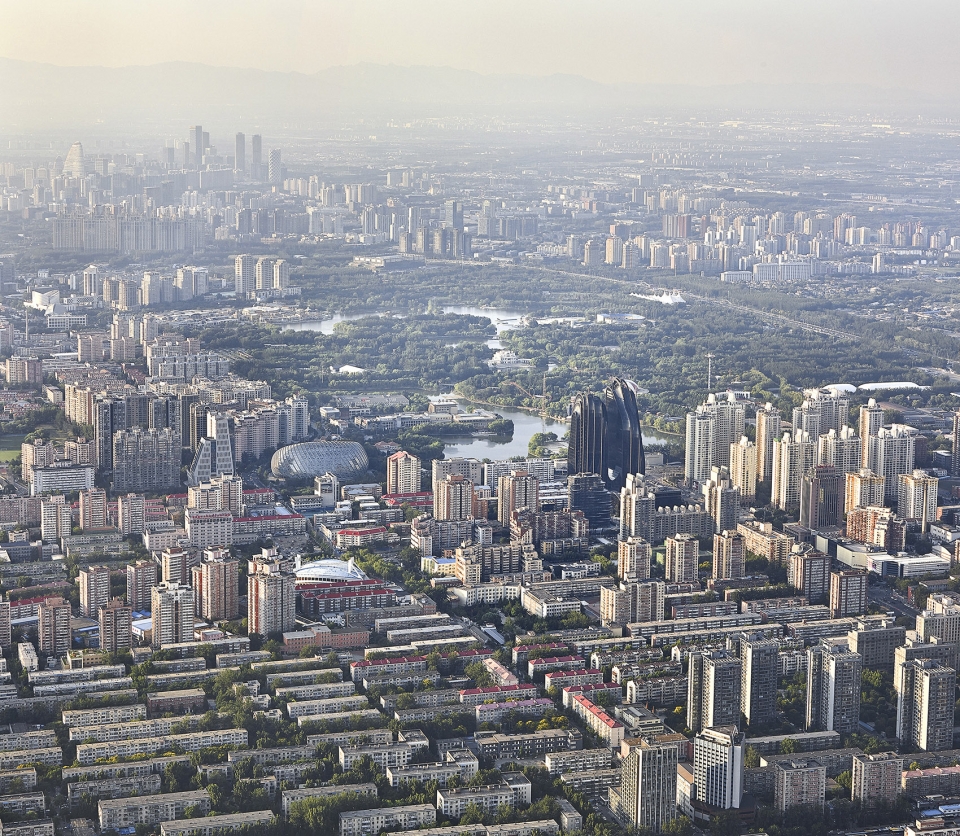 [/url]
[/url]
中国在现代化路程上,会把高层建筑当成现代化或者是国际化的标志,我不喜欢这样。在北京、尤其是在朝阳公园边上设计建筑时,我的眼里是自然。我想让建筑跟自然环境、历史环境产生对话。周边的一些建筑是在历史里某个时期的错误。这个错误变成现实的时候,很多人接受了,但我不能。我们现在要做的是更正错误,不能跟这些错误保持和谐的关系,然后犯更多更长远的错误。这种情况下,跟周边产生冲突是必要的,是我不得不选择的。建筑评论家王明贤作了一系列画,把北京的当代建筑放到了传统的山水画里面,其中有央视大楼、有鸟巢、有国家大剧院,都显得非常突兀,只有把朝阳公园广场放进去的时候跟古典的环境很融合。 During the modernization, China takes highrises as the milestone of internationalization and modernization. I simply disagree with that. When I was asked to design a mixed use next to the Chaoyang Park, what I saw and thought of was nature. I hope the buildings can have conversations with the surrounding natural environment and historic context. Some surrounding buildings are mistakes made decades ago. People accepted these “mistakes,” but I couldn’t. What we need to do now is to correct the mistakes. We cannot just make the new design to be harmonious with the mistakes. Otherwise, we’d just make bigger and further mistakes. In this way, contrast with the surrounding is necessary and inevitable. Wang Mingxian, an architecture critic created a series of paintings. He put contemporary buildings in Beijing into traditional Chinese landscape paintings, like CCTV new tower, Bird Nest and National Grand Theater. All these new buildings in the paintings seem quite awkward. But when Chaoyang Park plaza was added in, it looks quite harmonious in it. ▼从朝阳公园望向项目,建筑与自然环境和历史环境产生对话
View of the project from Chaoyang Park, creating dialogues between architecture and natural and historic environment
[url=]
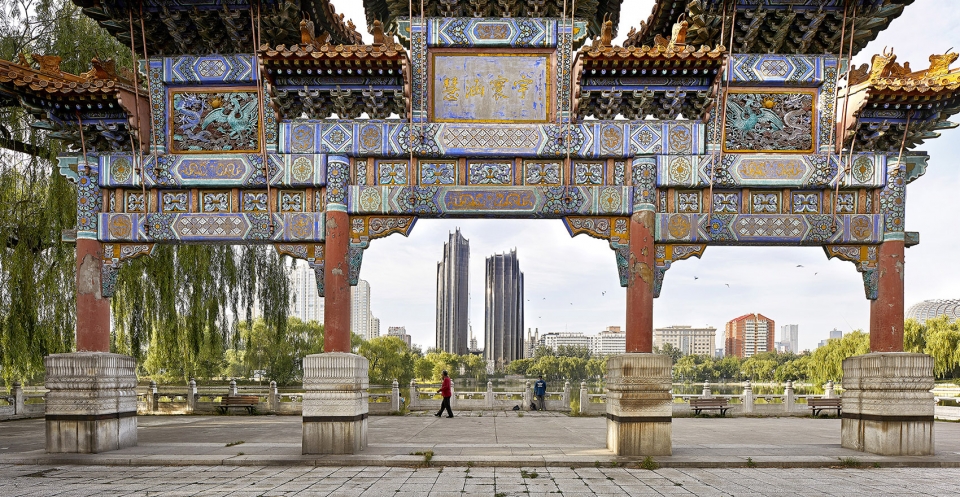 [/url]
[/url] [url=]
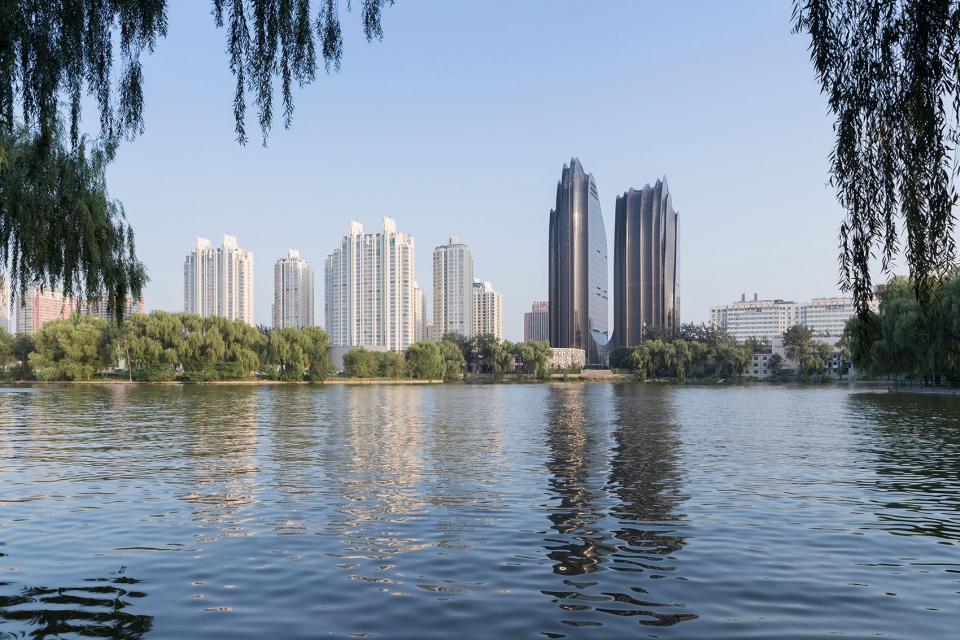 [/url]
[/url] [url=]
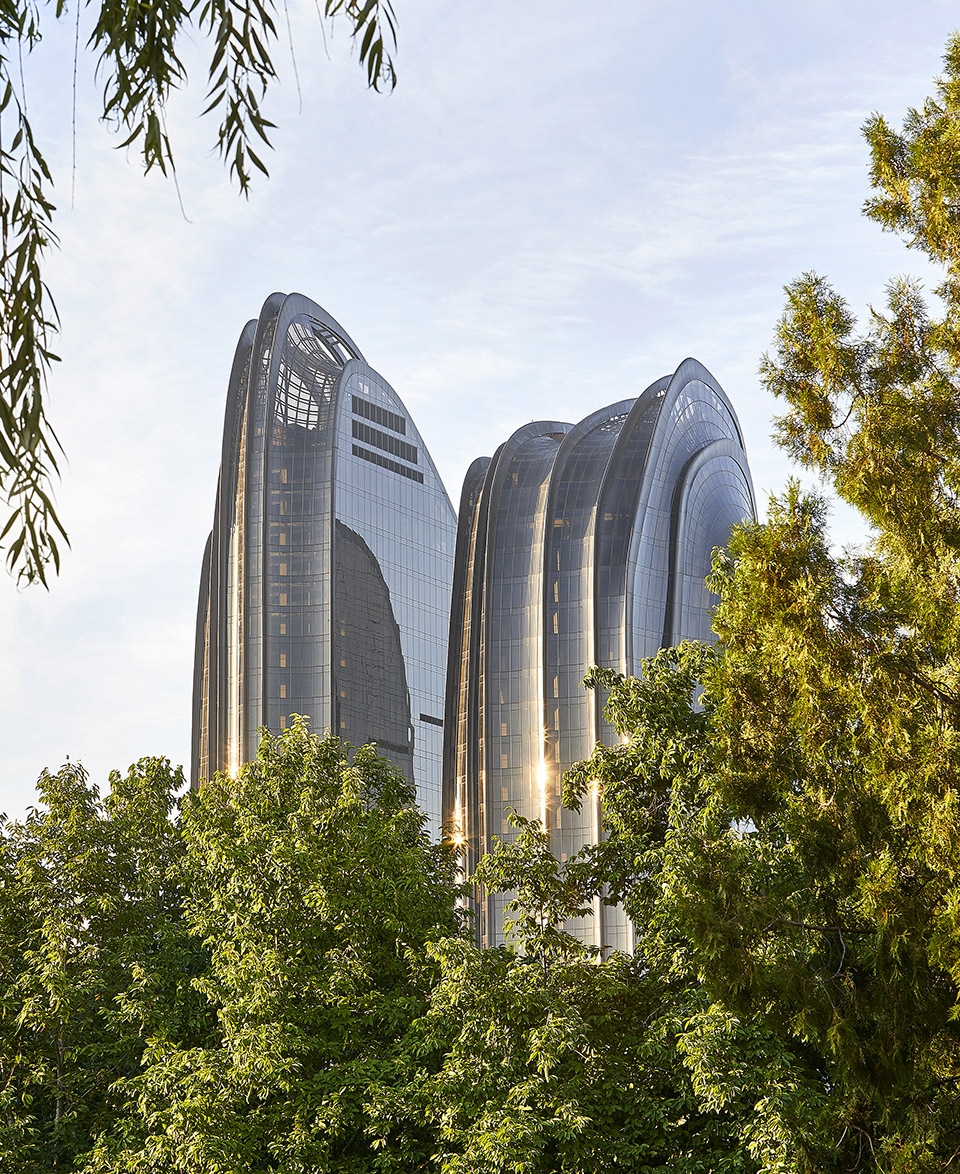 [/url]
[/url] ▼王明贤画作中朝阳公园广场与山水画相和谐
Chaoyang Park Plaza merges into the traditional Chinese landscape painting [url=]
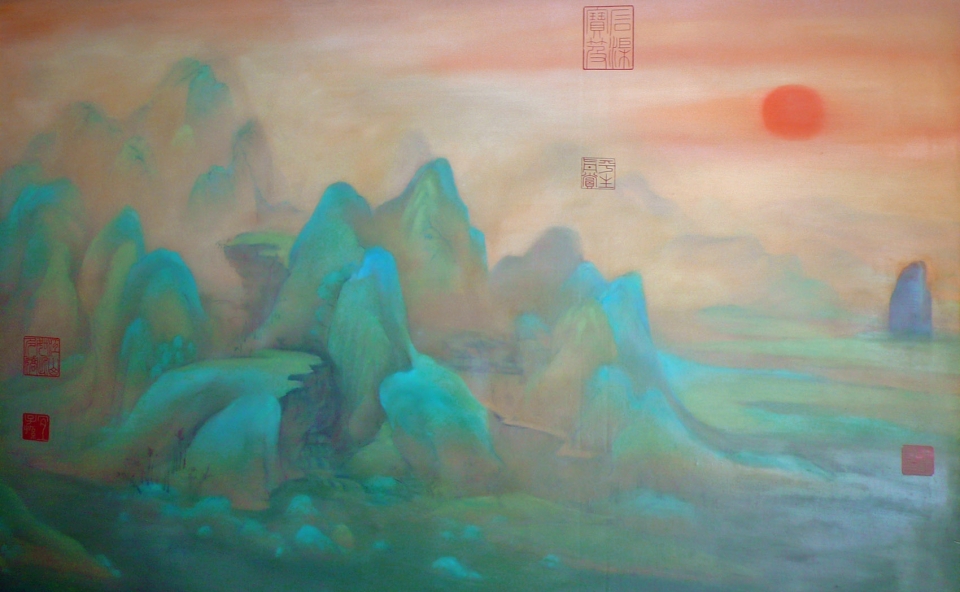 [/url]
[/url] 几十年的错误总有结束的一天,新文明总有开始的一天。转变和探索很重要,它们必定会带来各种视觉上、习惯上、审美上的冲突。如果把挑战和争议当成建筑本身的意义,那它成功地引起大家思考和讨论了:开始思考在大城市中是否有新的角度看自然和文化环境。我有很多朋友,都是中国文化界的先锋,他们都特别喜欢这个建筑。可能是因为大家都面临着相同的挑战吧:你的工作在更长的历史阶段里的意义是什么? There should be an end to the mistakes made from the past, a new start for a new kind of civilization. The transformation and exploration will be very important. From that it will bring in shocks in visual, custom and aesthetic value. If we take the challenge and discussion as the meaning of architecture, it did successfully trigger the public to think and discuss. They began to think if there would be a new angle to understand nature and culture in big cities.Many of my friends, who are pioneers in Chinese culture circle, like this project quite a lot. Maybe we are all facing the same challenge: What will your work mean to the world in the longer future? ▼朝阳公园广场成为城市的新地标,引发人们思考
Chaoyang Park Plaza becomes a new landmark of the city, encouraging people to think further
[url=]
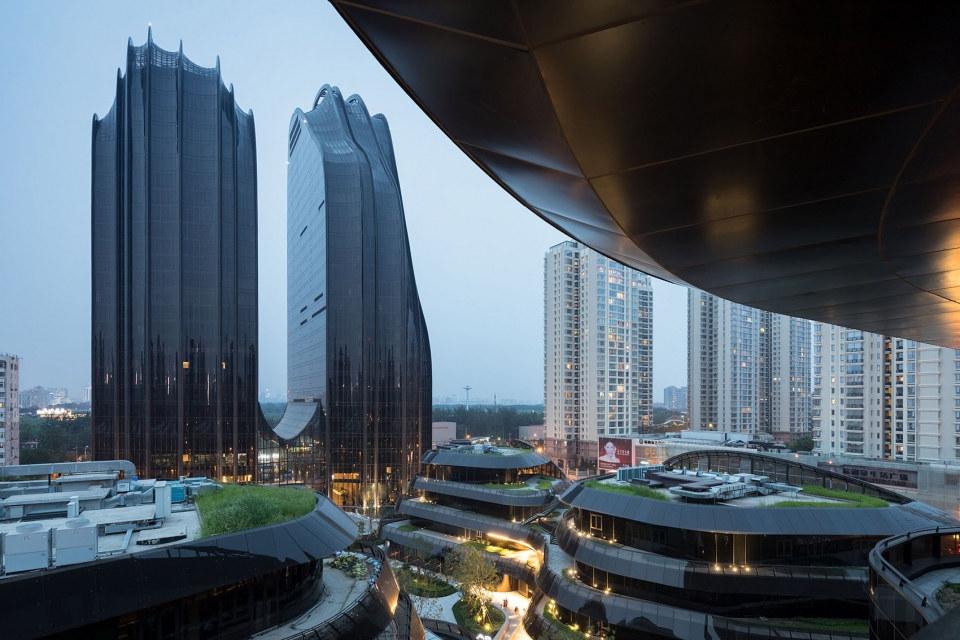 [/url]
[/url] [url=]
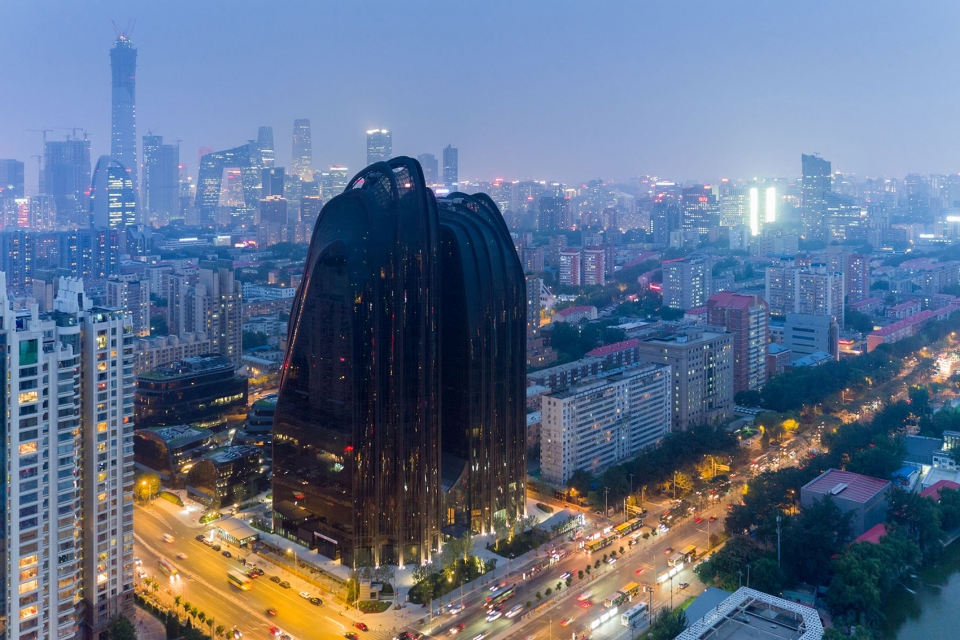 [/url]
[/url]
9. 怎样时刻保持清醒的呢?怎样保持这么多年的这个奋斗努力?
How to keep your mind refreshed all the time and fighting hard? 每个人都只能做自己。你可能会无形中被别人影响,但是被你喜欢的人影响也是因为那是你自己品质一部分。忠于自己最重要,无论作家、艺术家还是设计师,创作都是内心的表达,必须真实。你只能专注地发掘自己,更敏感地对待自己内心那些微小的感觉,更有意识地去屏蔽外界的影响,这样才更容易保持自我。日本有些工匠工作非常专注,他的信念、语言、方法,他的一切都是忠于自己的。当人到了这个程度,话语已经不是为了交流,不是为了说服别人,而是跟自己对话。这时你才能把自己最深的、跟别人不一样的东西发掘出来。 我一直相信历史是流动的,每个人在历史中都不能忽略自己的位置,不能因为自大或者过于崇拜历史,而让自己跟未来或者过去关系不清。我在现在的办公室看这个城市,看到历史的叠加,城市的变迁;古典的、现代的、不同时期的,都叠加在这。你的思想其实就是一个点,你要让这个点跟一个更大的历史对话。 What you should do is to be yourself. You might get influenced by others without knowing it, but that’s only because that changed part is part of your own quality. No matter you’re a writer, an artist or a designer, you need to be yourself. Your creation must be a true reflection of your heart. You need to dig deeper about who you are, be more sensitive about those subtle feelings, and to shield the influences from outside. Only that you can be true to yourself. Some craftsmen in Japan concentrate deeply in their work. All things around them, such as faith, languages, approaches, serve them to be true to themselves. When that level is reached, language for them is no longer for communication nor convincing others, but having conversations with their own inner selves. Only then you can find your true self and the difference from others. I always believe that we’re living in a moving history, in which everyone has his or her own position. You can’t be too arrogant nor overly worship the history. All that will make you confused about your relationship with the past or future. The view right now I’m looking at, from the central Beijing to the whole Beijing, is layered up histories, as well as transitions happened inside the city. From here, you can see different periods, traditional or modern, all here. You can take your thinking as a spot, and you need to make this spot to have a conversation with the greater history.
10. 最近在做的项目有哪些?你接下来最想实现的是什么?
What projects are you doing recently? What do you wish to realize the most in the near future? 我刚刚在日本参与一个艺术项目——越后妻有大地艺术祭,它跟濑户内海艺术祭是同一个发起策划人。越后妻有大地艺术祭,尝试用艺术来振兴乡村以及传统文化,已经做了十几年了。我参与的是其中一条隧道的改造。这条隧道以前是市政空间,主办方想把它变成艺术空间。隧道外面是峡谷和溪流,我们通过光、反射把室外的大自然带到隧道里,使隧道内外有一种超现实的连接,仿佛是跟自然对话的通道,在对话里创造新的意境。 I just finished a project in an art festival in Japan called Echigo Tsumari Triennale. It has the same founder as the Setouchi Triennale does. It has been held for more than ten years, trying to revitalize the rural villages and the traditional culture there. I participated in a tunnel renovation, where used to be a civic space. The client hoped to transform it into an art space. We introduced the valley and stream into the tunnel through light reflection, creating a surreal connection between in and out. It seems like it’s a passage to have conversations with the nature, from which you can find a new kind of artistic conception. ▼越后妻有大地艺术祭隧道,建立人与自然间的对话(点击这里查看更多)
Tunnel in Echigo Tsumari, creating communication between people and nature (click HERE to view more)
[url=]
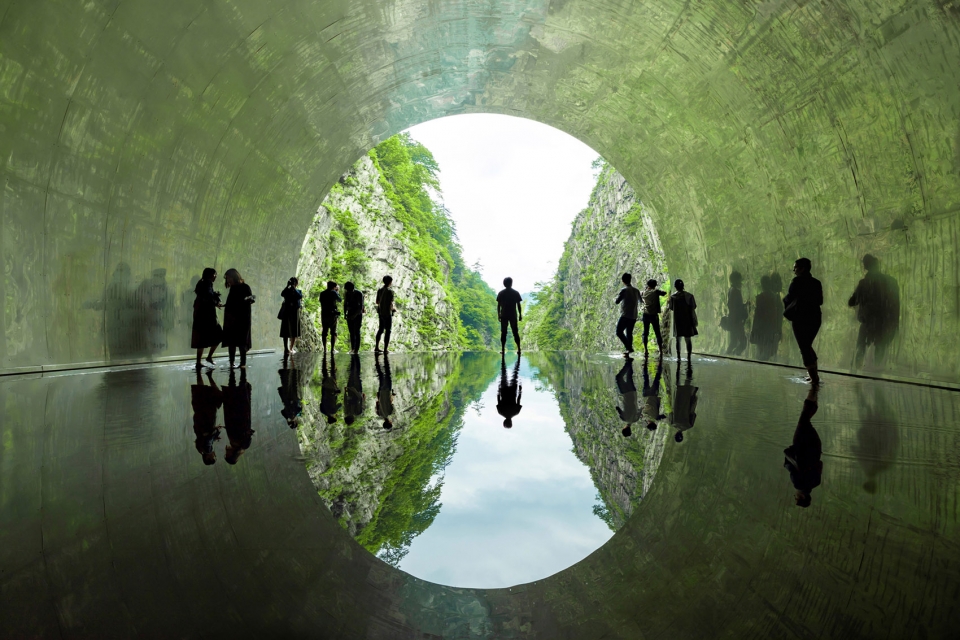 [/url]
[/url] [url=]
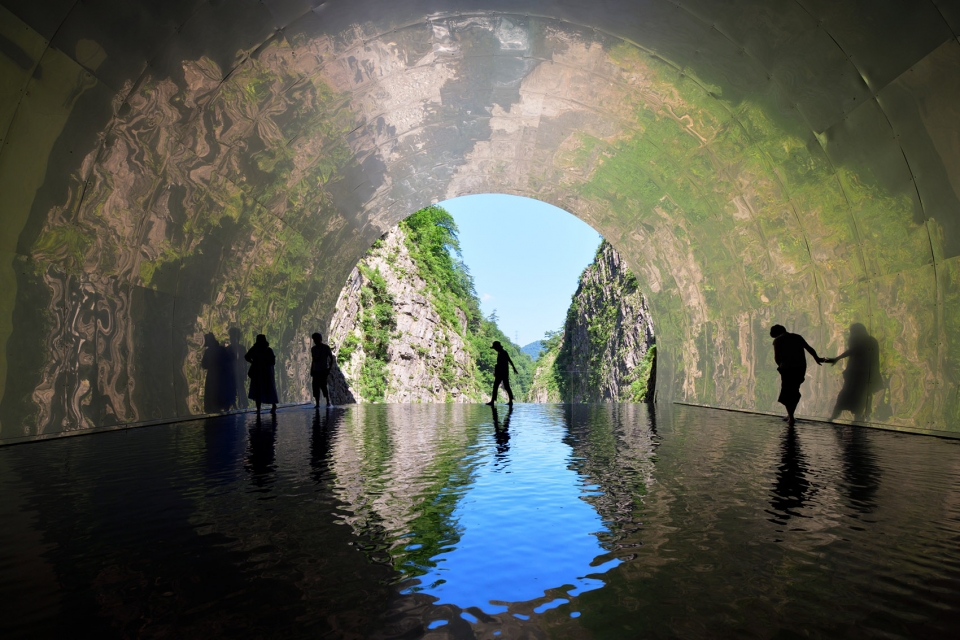 [/url]
[/url] 在东方,你看水、看沙漠、看海、甚至看一块石头都可能产生感觉,然后由这种感觉引发灵感转化成设计。在东方,“人工”与“自然”并不是简单的二元关系,东方谈的“自然”不是物理性的树、草、花,而是经过情感思考人工处理上升到精神层面的“自然”。 中国在谈很多乡村建设,用设计吸引外面的人。日本的方式有点不一样,它通过让设计师跟艺术家在当地合力合作,促使当地传统艺术被外界重新认识,让传统文化得到更好的保存。艺术是一种力量,是一种视觉的语言,用它做桥梁比大张旗鼓的城镇化改造可能更有效,或者说在情感上更真诚,我觉得中国可以借鉴。 In the East, water, desert, ocean, or even a piece of stone could be inspiration for artwork. Human and nature in the East are not in a simple binary relation. Nature in the eastern conception is not about the physical trees, grass and flowers. It is a sublimated spiritual experience after emotional thinking processing. Rural reconstruction is now a hot topic in China, attracting people from outside by design. It is a little different from what Japan is doing. In Japan, designers and artists work together with the rural area to have local traditional art to be reintroduced and reserved. Art is a visual language that could be more powerful and sincere than vast urbanization or renovation. I think China could use it for reference. ▼利用设计让传统艺术被外界重新认识
Introduce traditional art to outside world through design
[url=]
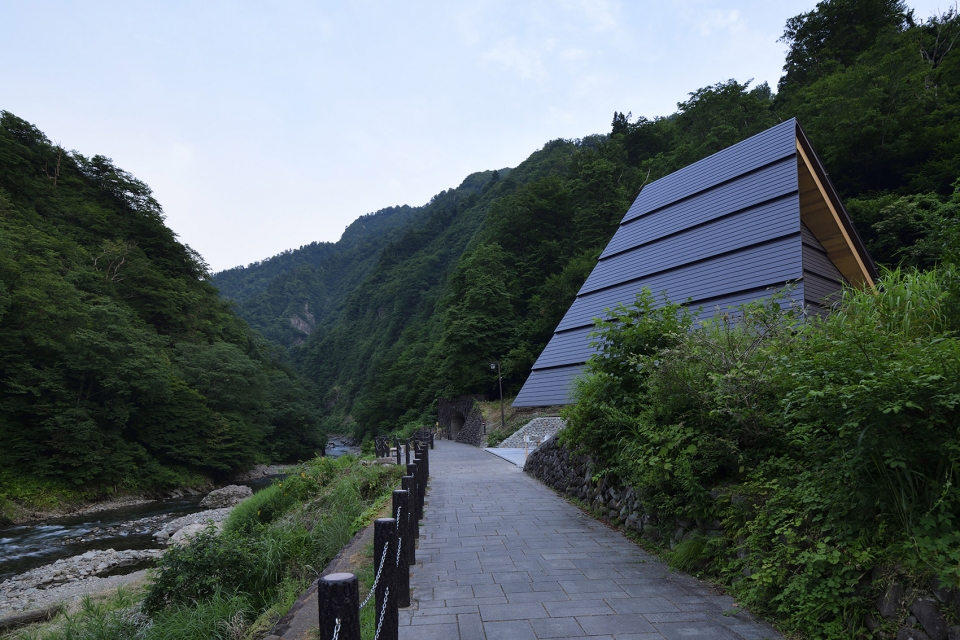 [/url]
[/url] [url=]
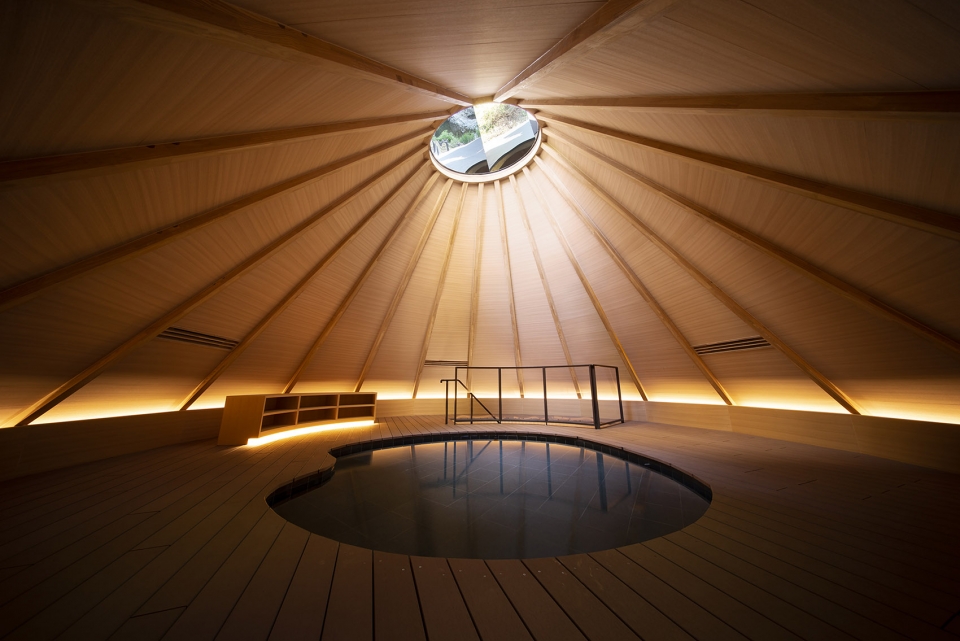 [/url]
[/url] 我们在巴黎和洛杉矶的两个项目会在今年建成,都是历时三四年的项目。巴黎和洛杉矶是两个拥有悠久的现代建筑历史的城市,我们当初希望通过与另一种文化的对话,为当地带来新的传统。这个目标能实现多少,我很期待。 Another two projects will be completed within this year in Paris and Los Angeles. Both of them have been going on over three to four years. These two cities own a long history in modern architecture. We hoped in the beginning that this kind of “conversation” with different cultures can bring in a new kind of tradition to the cities. I look forward to how much this goal will be realized. ▼即将完成的国际项目 – 巴黎UNIC住宅(点击这里查看更多)
International project going to be completed – UNIC in Paris (click HERE to view more) [url=]
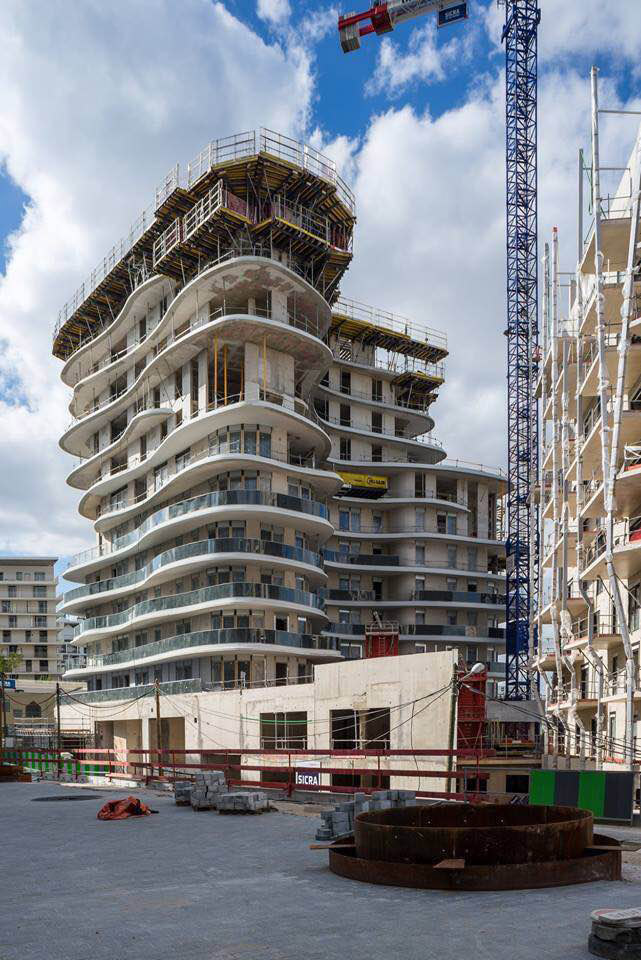 [/url]
[/url]
[url=]
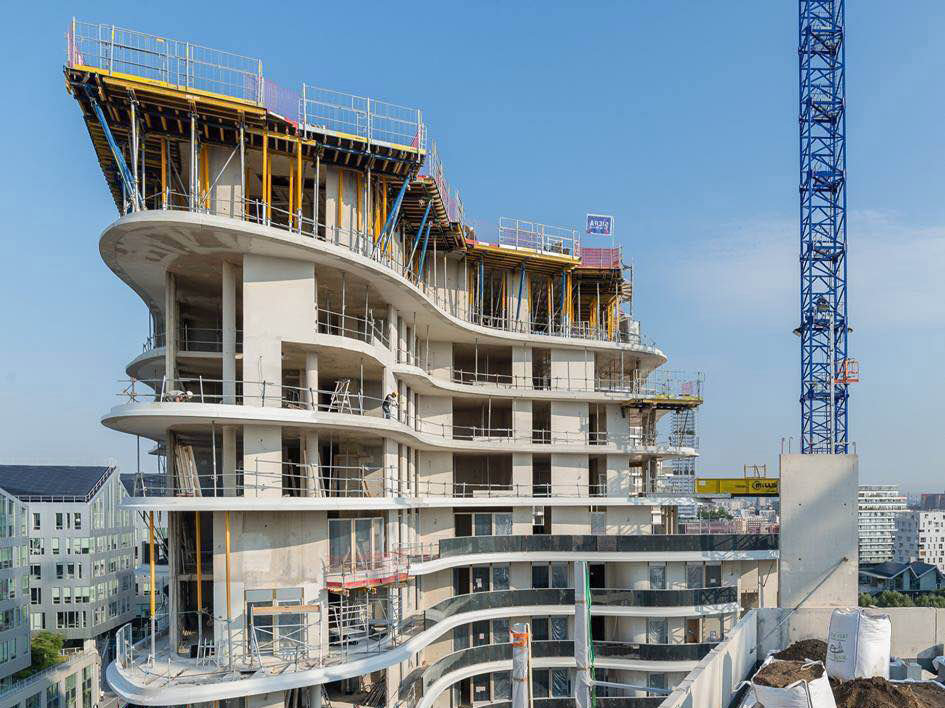 [/url]
[/url]
▼即将完成的国际项目 – 洛杉矶“花院”(点击这里查看更多)
International project going to be completed – Garden House in Los Angeles (click HERE to view more) [url=]
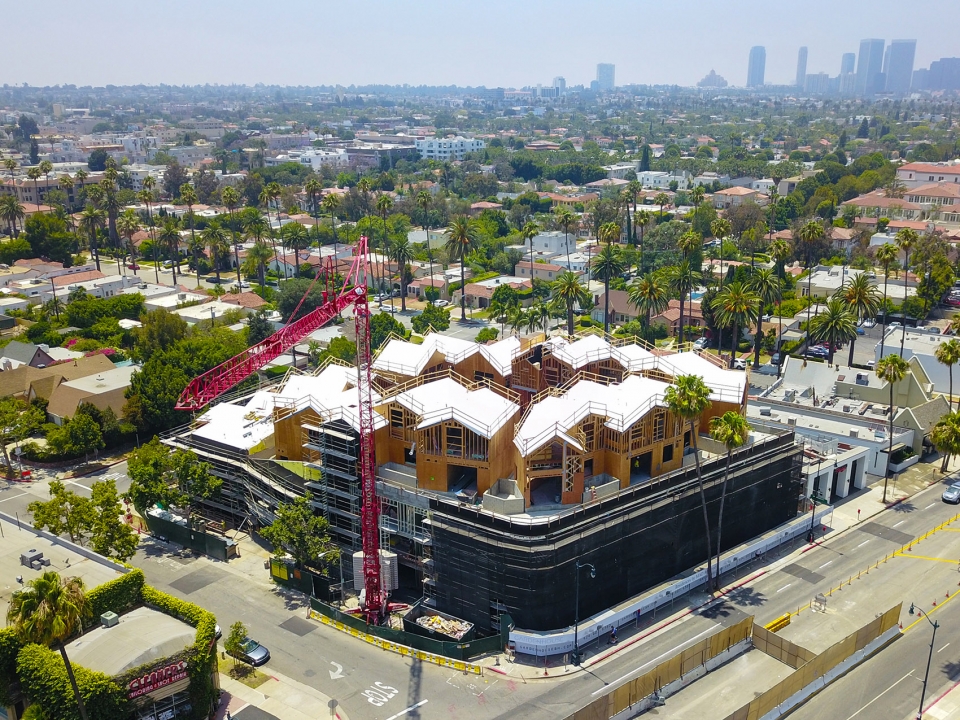 [/url]
[/url] 摄影师 | Photography credits
©Iwan Baan
©Hufton + Crow
©Adam Mørk
©Laurian Ghinitoiu
©Nacasa & Partners Inc.
©Fuji Koji
©Dan Honda
|
|
